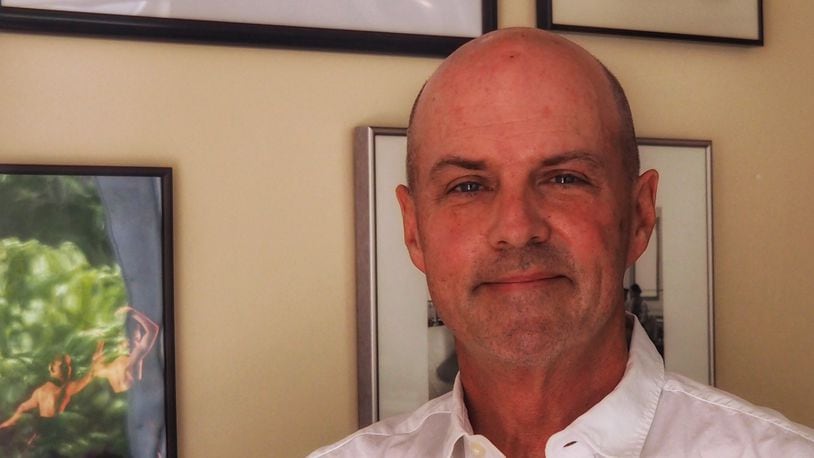Want more? Meet our previous Daytonians of the Week.
Futurism has always intrigued local photographer Andy Snow. A voracious reader all his life, he's been influenced by writers such as Ray Bradbury, whom he photographed when the famous science fiction artist was a guest lecturer at Wittenberg University. Bradbury said to him, “Andy, do what you love and the rest will follow.”
“I took it to heart,” Snow said.
He's a prolific photographer, and we asked, “What is your favorite photo you've ever taken?”
“The next one,” he replied. “I'm interested in the future and the next photo.”
He also clarified that he doesn't take photos. "I like to say we receive pictures."
“An image is a representation of the energy we receive,” he explained. “Photography is analogy.”
Although he didn't grow up in Dayton, Snow's roots are very deep. One of his ancestors — a farmer — settled here in 1804. Snow loves this area, along with its people and history, and he's completed an extensive project on the Great Flood of 1913. A video of "Watershed: Then & Now" is at visioneclectic.com.
Snow remarked how the flood was a “decisive moment” for Dayton, and that the community responded to the disaster by coming together. “It was neighbors helping neighbors,” he said.
Daytonians, Snow added, live with the “consequence of the river flowing through all of us – the heritage of helping each other, " and he is ecstatic over the recent news that the Dayton Arcade is receiving $20 million in housing tax credits for a redevelopment project, which he said illustrates the heritage of helping.
We caught up with Snow to dig deeper into what he does as well as his insights into Dayton.
Q. What do you do?
A. I've been making optically-based pictures continually since 1971 and videos since 1972 — starting with film and video tape, now all digital. I'm a working photographer in the arenas of art, editorial photojournalism and puzzle-solving marketing. In addition, I engage in a wide variety of community volunteer work with my experience and skills.
Q. Why did you get into photography?
A. My father, an MIT engineer, was an avid amateur. He always carried an Argus rangefinder when we traveled. He made color 16mm movies of us at Christmas. He was influenced by his grandmother, Margaret Weaver, who was born here in Brookville. "Mumma," as we called her, was a portrait amateur with her own darkroom. In the early '60s, she came to live with my grandmother in Easton, Conn., where we lived as well. Here in my files, I have some of her handmade prints in family albums.
My first camera was a Brownie I took to the Boy Scout National Jamboree at Valley Forge in 1964. I learned my first lessons with it; we used two of the photos in my how-to photography book published in 1994. Then, it was a trip to Puerto Rico in 1970 that piqued my interest again and I bought my first Nikon. Until matriculating in 1973, and while a philosophy major at Princeton University, I practiced at the studio/darkroom in the no-credit visual arts program while working as the research assistant to Peter Bunnell, my professor of Photography as Art History, the first chair of its kind. I was hired by a local ad agency to come to Dayton in 1974 to write and produce radio/TV commercials for Rike’s Department Store. This gave me access to many great creatives and clients that I continue to work with to this day.
Q. Through your eyes as a photographer, how do you see Dayton?
A. Big, bright, and busy. A rising shining star with all the challenges of a small American city in this era. I see people working hard to help each other succeed through so many channels. While living downtown since 1989, I've witnessed many changes, especially recently in the ongoing economic development sphere. Many exciting projects on the horizon just as the I-75 exits are be completed. Timely indeed.
Q. What's your favorite spot in Dayton to photograph?
A. My favorite place to make photos is wherever I am at the time with whatever camera I have. There's always the energy field of a picture nearby waiting to be perceived, recorded and shared. Some say the hardest place to photo is one's own back yard. Because you look at it every day. Keen observation is key. Seeing the familiar with fresh eyes is an ongoing mindful practice. Of course, I make many photos at and around the Great Miami River, as part of my yard-scape, if you will. The Flood of 1913 Anniversary Project so oriented me. There's beautiful light all around us early and often. A great place to be.
Q. What inspires you about Dayton and the area?
A. The strength of our collective empathy coupled with the resilience and endurance of community services for those who need assistance. People stepping up to help their neighbors. It's a revelation and an inspiration. URS, The Food Bank, Equitas, United Way, Daybreak, Miami Valley Fair Housing Center … the list goes on and on.
Q. What do you think Dayton will look like in 10-15 years?
A. Dayton will continue to change physically. The heart-and-soul of the region will remain artistic, inventive and stimulating. Yet it will continue to be steadfast in its resolve to assist and support all within its diverse ecosystem. That's the beauty of our community here.
Q. Your photography brilliantly captures the beauty of our community. Where can people see your work?
A. My website is now 20 years old — I built it and put it up myself in 1996: andysnow.com.
About the Author
